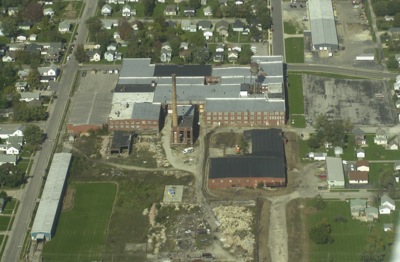Thursday, January 4th, 2007
EPA to allow local landfill to expand upward
By William Kincaid
The local landfill will grow higher.
The permit application allowing the Celina Sanitary Landfill to expand vertically has been approved by the director of the Ohio Environmental Protection Agency (EPA).
The director approved the upward expansion of the landfill, located south of Celina on U.S. 127, late last week after reviewing the application for nearly a month. The landfill was expected to run out of space by the end of the year, if it could not expand its permitted height.
The approved vertical expansion over the Phase II area of the landfill - the east mound, west mound and center cell - will increase the current height by a maximum of 20 feet over 49.5 acres. This will provide an additional 1.52 million cubic yards of space for trash.
It also will extend the life of the landfill by 51/2 years, if the facility receives a maximum daily waste collection of 499 tons, or by 10 years, if it maintains its an annual average waste collection of 95,000 tons.
The upward expansion includes constructing various liner systems over existing trash, so more trash can be added on top. The liners, made of recompacted clay, are needed to prevent contaminated water, known as leachate, from draining further down the landfill, according to Mercer County Sanitarian Chris Miller.
The expansion plan also includes surface water management, ground water monitoring, explosive gas monitoring and a final cap system.
Before starting any construction, landfill officials must notify both the Ohio EPA and the Mercer County Health Department seven days prior, so the two entities can perform routine inspections.
Adam Burleson, facility manager of Celina Sanitary Landfill, said construction of any kind will not start for at least a month.
"We've still got to establish a staking plan ... get with surveyors," he told the paper Wednesday afternoon. "There's no immediate plans."
The approved expansion permit also says the EPA director, or another authorized representative, may enter the premises at any reasonable time during construction and operation for the purpose of making inspections, conducting tests or examining records or reports.
The approved permit will cost the landfill nearly $15,000, which must be paid by Jan. 28.
Landfill officials earlier stated they ultimately want both a vertical and lateral expansion. They said a vertical expansion would give the committee ample time to consider an additional lateral expansion.
Chance to appeal:
Local residents still can appeal the recent EPA approval to expand the Celina Sanitary Landfill.
Many neighbors spoke out against the vertical expansion during a public hearing and information session held by the Ohio EPA on Nov. 14.
Appeals can be sent to the Environmental Review Appeals Commission, a state appellate review commission separate from the Ohio EPA. A written appeal must set forth the action complained of and the grounds upon which the appeal is based.
The appeal, which must be received by Jan. 28, and a $70 filling fee can be sent to the appeals commission at 309 S. Fourth St., Room 222, Columbus, OH 43215.
Along with approving the expansion, the EPA also responded to public concerns. Listed below are the residents' concerns or questions and the EPA answers:
• There is concern about litter blowing around as the landfill gets higher.
The Ohio EPA wrote that Celina Sanitary Landfill must continually address blowing litter at any elevation as required by law. Ohio EPA and the Mercer County Health Department will continue to inspect the facility to oversee compliance with this rule.
• Odor, noise, blowing paper and litter have been a problem in the past - what will be done to control theses items in the future?
These items must be addressed every day by every municipal solid waste facility, the EPA wrote. If not addressed, violations can be cited and enforcement actions can be undertaken. Ohio EPA and Mercer County Health Department will continue to inspect the facility.
• Neighbors are concerned about contamination of groundwater and how it will affect both their lives and their livestock.
EPA engineers review all landfill designs to ensure the liner guards against any release to groundwater, the EPA wrote. Groundwater monitoring will be performed to detect if there has been any release from the landfill to groundwater. The facility is required to keep a 15-foot minimum separation distance between the uppermost aquifer system and the bottom of the composite liner system.
• How will we be certain the landfill will not affect the underground aquifer system that is part of the Teays River Valley?
Celina Sanitary Landfill has demonstrated that the thickness and low permeability of the lower till unit acts to retard downward groundwater flow, thus posing a barrier to potential leachate releases. The landfill has calculated that the vertical time of travel through the lower till to be between 290 and 460 years.
• There is a concern about property value depreciating because of the landfill, increased traffic and mud on the roads.
Many businesses and community services impact local property values. Controlling the proximity of these developmental activities to adjoining land uses in order to protect property values is best addressed at the local level through zoning. Ohio environmental laws and regulations do not provide the Ohio EPA any authority over issues relating to the location of the facility and its impact upon adjacent property values, the EPA wrote.
- William Kincaid

